|
 Secure Site
Secure Site
|
 |
Archive for the 'Chime Alarm Clocks' Category
 create a sacred place to be mindful Is there a place in your home or yard where you can let go, relax, and renew your awareness of transcendent, loving oneness? It doesn’t take much to create such a place.
Your can create your healing retreat —a garden, a teahouse, a room—or you can claim one that already exists—a window seat, a rock by a stream. Your haven can be a balcony with potted plants and a wind chime, a hot tub surrounded by lavender, a bedroom where you have banished all distractions, or a comforter you roll up in like a cocoon. It needn’t even be a particular place; it can be an experience you recreate each time you need it, like a candlelight bubble bath with fresh flowers and Mozart.
There are no rules about how to create a personal haven, but consider incorporating some of these features (let your heart and your gut guide you):
• A gateway or marked entry to set it aside as sacred
• Privacy (freedom from interruptions and demands)
• A place to rest (a bed, hammock, comfortable stool)
• Calming colors
• Curved shapes
• Soft textures
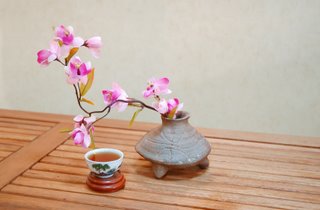 create a sacred space in your house • Plants
• Objects of beauty
• Simplicity, absence of clutter
• Soothing sounds (birdsong, moving water, music, wind chimes)
• Sunlight or soft, warm electric light
• Pleasing scents
• The four elements: air, earth (the ground, stones), water (in a bowl, fountain, or body of water), fire (sun, candles, a fire)
• A long vista, if there’s a pleasant one available
• Symbols of calm, transcendence, love, nourishment (hearts, stars, sun, moon, angels, personal treasures)
You deserve it
If you are like most people, the hardest part isn’t finding or creating a sanctuary; it’s believing that you deserve to spend time there. We tend to be so overwhelmed with demands that time taken away from meeting them feels like time wasted. We somehow learned that doing something just because it feels good is detrimental to others. Question these assumptions.
In fact, great inspiration, beautiful works of art, and profound love arise from the experience of unstructured time. In quiet, we can hear our muses and feel our passions. Here we can dream freely and drink from the deep well of our source. The peace we find carries into all our actions and relationships. What better gift can we give the world?
Although meditation can be done in almost any context, practitioners usually employ a quiet, tranquil space, a meditation cushion or bench, and some kind of timing device to time the meditation session. Ideally, the more these accoutrements can be integrated the better. Thus, it is conducive to a satisfying meditation practice to have a timer or clock that is tranquil and beautiful. Using a kitchen timer or beeper watch is less than ideal. And it was with these considerations in mind that we designed our digital Zen Alarm Clock and practice timer. This unique “Zen Clock” features a long-resonating acoustic chime that brings the meditation session to a gradual close, preserving the environment of stillness while also acting as an effective time signal.
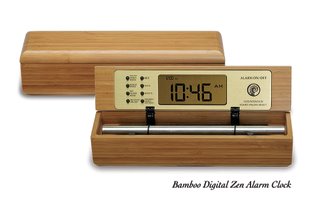 Bamboo Meditation Timers and Alarm Clocks
adapted from Natural Home Magazine, January/February2004 by Carol Venolia
 interiors that create well-being Now & Zen
1638 Pearl Street
Boulder, CO 80302
(800) 779-6383
Posted in Beauty, Chime Alarm Clocks, intention, Japanese Inspired Zen Clocks, Meditation Timers, Meditation Tools, mindfulness practice, Well-being, Zen Timers
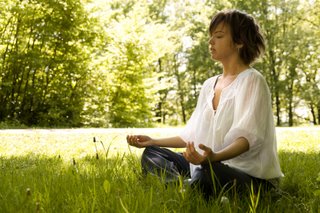 meditation guide With practice, this beginner meditation will hold the mind steady even during periods of stress.
A well-trained, stable, and focused mind is an asset in every sphere of life, and essential for any spiritual endeavor. The practice below will develop your concentration, clarity, and inner stability, by providing a single object as the resting place for your mind’s awareness—the universal mantra soham. Practice daily at about the same time, set your Meditation Timer by Now & Zen for 10 minutes, starting with 10 minutes, and gradually increasing to 20–30 minutes, or longer.
Step 1.
Begin by training your body to be still and comfortable in a sitting posture. When the spine is erect with the pelvis, chest, and head vertically aligned, the breath becomes smooth, and the mind alert and relaxed. Sit on a chair, or cross-legged on the floor with a cushion or a folded blanket under the hips. Use enough support to lift the hip joints slightly higher than the knees. This minimizes the effort needed to keep the lower back from rounding.
Step 2.
Close your eyes and mentally draw a circle of light around yourself. The circle separates you from the world of daily life—both the outer world of perceptions and activities, and the world of your familiar preoccupations and thinking patterns. With this intention, see yourself sitting inside this circle of light. It delineates a space in which you can contain your awareness; let it protect you from disturbances, distractions, and mental dissipation.
Step 3.
Feel the entire body sitting comfortably still, release any unnecessary tension, and pay attention to the movement of the breath. Refine your awareness as you feel the breath become smoother and more subtle, expanding from the solar plexus into the limbs on the inhalation, and releasing back to the solar plexus on the exhalation. Be aware of the touch of the breath everywhere in the body.
Step 4.
Making sure the body and breath stay relaxed, focus your attention at each of the following energy centers, moving systematically through the body and inhaling and exhaling once at each point: eyebrow center · throat center · right shoulder · right elbow · right wrist · each of the right fingertips, starting with the thumb · right wrist · right elbow · right shoulder · throat center · left shoulder · left elbow · left wrist · each of the left fingertips, starting with the thumb · left wrist · left elbow · left shoulder · throat center · heart center · navel center · center of the pelvis · pelvic floor · center of the pelvis · navel center · heart center · throat center · eyebrow center.
Step 5.
Now rest your attention at the eyebrow center. Feel the ebb and flow of the breath through the inner space of the whole body, while maintaining your focus on the eyebrow center. Sense the vibration of a slow wave of breath. This vibration is the mantra soham (pronounced so-hum). Hear the sound so on the inhale, and the sound ham on the exhale. The breath is subtle and slow, so let your concentration be fine and sensitive, becoming more and more one-pointed, and gradually drawing deeper into the mind. Rest in this awareness as long as you like.
To finish the practice, gradually return your awareness to the flow of the breath in the body, the physical presence of the body, and the space around you. Remain aware of the breath and your inner connection as you release the body from your sitting posture. You may want to open your eyes into the palms of your hands, massage your face, and stretch your arms and legs before getting up.
Use our unique “Zen Clock” which functions as a Yoga Timer. It features a long-resonating acoustic chime that brings your meditation or yoga session to a gradual close, preserving the environment of stillness while also acting as an effective time signal. Our Yoga Timer & Clock can be programmed to chime at the end of the meditation or yoga session or periodically throughout the session as a kind of sonic yantra. The beauty and functionality of the Zen Clock/Timer makes it a meditation tool that can actually help you “make time” for meditation in your life. Bring yourself back to balance.
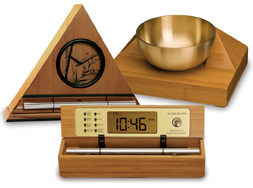 Meditation Timers with Singing Bowls & Chimes adapted from Yoga International Magazine, by Sandra Anderson
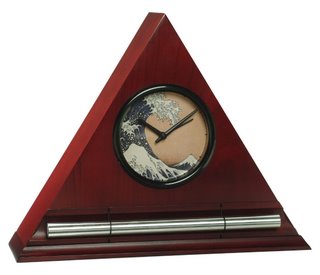 Zen Alarm Clock, Ukiyo-e Hokusai Wave Dial Face, mediation timer and clock Now & Zen’s Meditation Timer Store
1638 Pearl Street
Boulder, CO 80302
(800) 779-6383
Posted in Chime Alarm Clocks, Meditation Timers, Meditation Tools, mindfulness practice, Now & Zen Alarm Clocks, Well-being, Zen Timepiece by Now & Zen, Zen Timers
 Morning You don’t have to be a naturally early riser to enjoy all that the morning has to offer. With the right perspective and a few small adjustments, you can turn your morning into one of the most relaxing and energizing parts of your day.
“The morning has incredible potential,” says Alison Novie, senior yoga instructor at Kula Yoga in Manhattan. “I think of the new day as a new year — a whole new life. If you could modify just a few things about your morning, it would change the way you see your day.”
To some degree, you don’t have much choice about how you feel when the sun comes up. Not everyone is born a morning person. But that doesn’t mean your mornings can’t change for the better. It’s worth tinkering with your natural inclinations to reap the rich rewards.
Quiet, full of expectation, yet uncluttered by conversation and untouched by the demands of the day, the morning presents an opportunity for you to find joy, peace, and strength — or at the very least, the chance to ease into the flow so that you aren’t thrown into your day headlong and half awake. We’ve spoken with a renowned sleep expert, a yoga instructor, and a Reiki healer for their insights on everything from getting a good night’s sleep to practicing mind/body awareness to incorporating a sense of play early in the day. Their strategies work well together or individually. Find the ones that work for you, and enjoy them in and around your current morning chaos, whether you live alone, with two dogs, or with five kids. By taking the time to stimulate your senses and relax your body and mind, you’ll start out calmer, more energized, and better prepared for whatever lies ahead.
Reset Your Natural Alarm
First things first: You’ll never enjoy the morning if you don’t get a good night’s sleep. For some people, that means a solid nine hours of uninterrupted slumber; for others, seven hours of shut-eye will do. Sleep expert James B. Maas, Ph.D., author of Power Sleep, notes that eight hours of sleep is the average — but only an average, not a rigid goal. When you’re not getting enough sleep, you’re the first to know. Shifting your sleep schedule is possible, says Maas, but it requires commitment. “If you’re a night person, and you want or need to become a day person, you can do it, but you have to be serious about it. You can’t flip-flop,” he advises. Here’s how to alter your habits in favor of an earlier (and happier) morning.
Make a gradual shift. If you find it hard to fall asleep at night, take things slowly when it comes to establishing a new time for bed. Try hitting the hay five minutes earlier each night, and in less than two weeks you will have shifted your bedtime by one hour.
Resist the urge to snooze. Hitting the snooze bar is an exercise in futility — and torture. You’ll get at best 5 or 10 minutes of fragmented sleep, notes Maas, and may arise feeling groggier than when your alarm first went off. Instead of sneaking in 10 more minutes of sleep, try going to bed 10 minutes earlier instead.
Expose yourself to bright daylight. This is one of the best and most effective things you can do to wake yourself up, says Maas. By opening the curtains and the windows or getting outside, you cue your brain to repress the production of melatonin, the hormone that regulates sleep. Natural daylight works best, but if you get up before sunrise or simply can’t get enough natural light, consider using a sun-mimicking device as an alternative.
Don’t lose sleep over exercise. While you may choose to exercise in the morning, Maas recommends against sacrificing sleep for it. “Never truncate your sleep in order to work out. This puts you at a greater risk of injury,” he advises. Only when you have had enough uninterrupted hours of sleep should you think about getting up to exercise.
 Chime Alarm Clocks and Meditation Timers - Mother and daughter Harunobu Be consistent. “You don’t get two biological clocks — one for weekdays and one for weekends,” says Maas. “That means you have to stick by one.” Sleeping late on the weekends to compensate for lack of sleep during the week will throw you off, making Monday mornings even worse than they need to be. While keeping a consistent sleep schedule is ideal, it’s not always reasonable or practical. Your best bet is to try to keep your schedule fairly regular (that is, getting up and going to bed within an hour or so of your weekday schedule).
Plan your evenings. How you wind down the day may affect the quality of your sleep — and therefore the quality of the following morning. For some, eating a chocolate bar, watching a dramatic movie, or arguing right before bed will be enough to derail sleep. Be aware of your particular sensitivities; avoid those things you know will keep you up.
Boulder, Colorado—an innovative company has taken one of life’s most unpleasant experiences (being startled awake by your alarm clock early Monday morning), and transformed it into something to actually look forward to. “The Zen Alarm Clock,” uses soothing acoustic chimes that awaken users gently and gradually, making waking up a real pleasure. Rather than an artificial recorded sound played through a speaker, the Zen Clock features an alloy chime bar similar to a wind chime. When the clock’s alarm is triggered, its chime produces a long-resonating, beautiful acoustic tone reminiscent of a temple gong. Then, as the ring tone gradually fades away, the clock remains silent until it automatically strikes again three minutes later. The frequency of the chime strikes gradually increase over ten-minutes, eventually striking every five seconds, so they are guaranteed to wake up even the heaviest sleeper. This gentle, ten-minute “progressive awakening” leaves users feeling less groggy, and even helps with dream recall.
adapted from Body +Soul Magazine, March 2006
Now & Zen’s Chime Alarm Clock Store
1638 Pearl Street
Boulder, CO 80302
(800) 779-6383
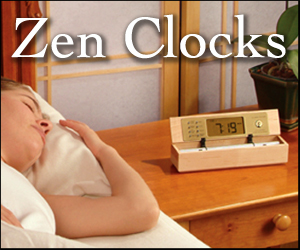 Chime Alarm Clocks - The Digital Zen Alarm Clock
Posted in Chime Alarm Clocks, Natural Awakening, sleep, Sleep Habits, wake up alarm clock, Well-being
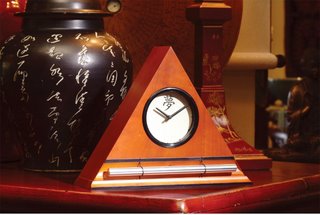 Zen Alarm Clock Zen Awakening
Is waking up to a blaring alarm really necessary? Now & Zen founder Steve McIntosh thought there had to be a better way, so he invented alarm clocks with soft, repeating chimes that wake sleepers gently. “Unlike every other alarm clock on the market, these wake you up with an acoustic sound, not a recorded one,” he says. Referring to notes on the musical scale, he adds, “You hear either an E-toned chime bar or a B-tone, the same sounds used by musical therapists.”
Unlike the snooze button, which jerks you awake again and again, Now & Zen clocks wake you gradually. “The first chime sounds, and then it’s silent for the next three and a half minutes,” McIntosh explains. “Over 10 minutes, the chimes become closer together.”
McIntosh says satisfied customers include notoriously hard-to-wake teenagers—and their parents.
 Digital Zen Alarm Clocks and Timers, available in maple, walnut, bamboo, and black lacquer Now & Zen Digital Zen Alarm Clock in natural wood or bamboo case: $110 for B tone; $120 for E tone. (800) 779-6383
adapted from Natural Home Magazine, November/December 2009
Now & Zen – The Zen Alarm Clock Store
1638 Pearl Street
Boulder, CO 80302
(800) 779-6383
Posted in Bamboo Chime Clocks, Chime Alarm Clocks, Japanese Inspired Zen Clocks, Natural Awakening, Now & Zen Alarm Clocks, Progressive Awakening
 Decluttering a bedroom space, Digital Zen Alarm Clock What’s the first space in your home that experts recommend tackling when you declutter? If you said the living room, kitchen or foyer, guess again. It’s the bedroom.
“I always start with the bedroom,” says feng shui consultant Andrea Gerasimo of Menomonie, Wisconsin. “It’s your sanctuary.” Gerasimo cites studies showing that what you’re thinking when you nod off affects how you sleep and your mood when you wake up. So if your last mental image is of chaos and clutter, you’re not setting the right stage for quality sleep.
In your bedroom space, do you trip over piles of clothing, boxes, shoes and assorted tchotchkes? Are stacks of DVDs careening from your bedroom entertainment center? Or, perhaps you’ve placed your home office—with its tangle of computer and phone lines, file folders, sticky notes and miscellaneous office supplies—in your sleep space.
The good news is that you don’t have to remodel to streamline your bedroom.
Rearranging furniture (even better, removing a few items), decluttering and adopting a resolute mindset to keep your bedroom space harmonious and clutter-free are simple steps that can make a big difference.
Transform your bedroom from cluttered chaos to serene retreat with these easy tips.
1.Furniture: Less is More
Having too many dressers, tables and chairs jammed into a space—no matter how large—makes it feel smaller. And stuff attracts more stuff. As we add more pieces, we tend to fill them, inside and out.
Solutions:
■ Invite a friend with a fresh set of eyes over for a streamlining session. Move everything out, then open your mind to new arrangements. Bring in the pieces you love most until the room seems adequately furnished but not overly stuffed; the remaining furniture is probably unnecessary. Choose a Zen Alarm Clock for the space next to you bed on your table. Pick the Digital Zen Alarm Clock that has a lid that can be closed to further declutter your bedroom space.
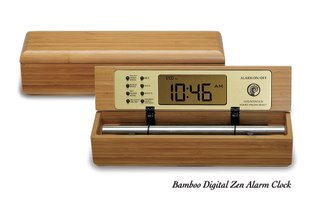 Bamboo Digital Chime Clock, closing the lid to the clock helps declutter your bedroom space ■ Think about what you can donate, use elsewhere or sell. Candidates for the chopping block may include exercise equipment, a dresser, even your television. Family manager coach Beth Dargis of Holland, Michigan, singles out dressers as occupying too much space in a room. (What’s more, their long, low surfaces invite clutter, she says.) Whenever possible, Dargis recommends replacing a dresser with a highboy, which holds roughly the same number of items but with a smaller footprint.
■ While everything is out of the room, consider spiffing up your walls with a fresh coat of no- or low-VOC paint (VOCs are volatile organic compounds that outgas into the air). If you want to change your window treatments to hemp or organic cotton, this is an ideal time. At the very least, give your bedroom a good, thorough cleaning before moving furniture back in.
2.Clothing: The Hidden Culprit
Anytime you declutter a bedroom, you invariably run into a surfeit of clothing, shoes and accessories. This accumulation is the root cause of a number of ills. “People cram in another piece of furniture instead of going through their wardrobes and getting rid of what no longer fits,” says New York interior designer John Loecke, author of the Organizing Idea Book (Taunton, 2006). Many times, Loecke has seen couples introduce substantial armoires to their bedroom space to accommodate one person’s wardrobe because the other’s has overtaken the closet.
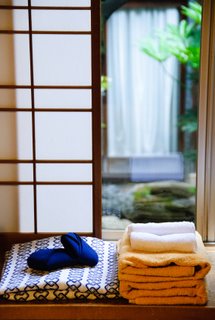 zen-like bedroom Solutions:
■ First, simply pare down. Set aside half a day (with a decluttering buddy, if you can find one) and go through your wardrobe ruthlessly, donating what no longer fits, what you haven’t worn in a year or two, and what’s outdated. Take everything out of the closet and put it in piles to donate or consign, trying on only the items you aren’t sure about. (In the process, I guarantee you’ll discover at least one “treasure” that you’ll want to reclaim!)
■ Once you’ve whittled down your wardrobe, adopt a practice I’ve been following for years. Put two containers in your closet: one for donation, one for consignment. As soon as I wear an item and decide it’s no longer for me, I place it directly into one of the boxes. As soon as one fills, I pop it in my car and drop it off at my charity or resale shop.
■ Once you’ve reduced your holdings, you’ll be surprised at the amount of space you’ve freed up. Before you begin to reload, take this moment to sort everything by category—separate all shirts, dresses, pantsuits and tops into categories. Organize shirts and blouses according to color, from light to dark, or by use, such as dress shirts and T-shirts. This system helps you see what you have. (If you still have more than your closet will bear, and if you have a climate-controlled attic or basement space, you can rotate out-of-season items.)
■ To further streamline, remove as much as possible from the closet floor. A hanging shoe rack helps get shoes up and in sight. The same goes for ties, belts, scarves and hats. As you organize your wardrobe, it’ll be easier—and obvious—to see what you have and which items to chuck.
3. Streamline Bedding
Sometimes the bed itself—including all the attendant bedding and pillows—can create visual clutter.
 how to declutter your bedroom space
Solutions:
■ Bed size—like just about everything else in America these days—has become supersized. But do you really need a king-size bed? When you’re shopping for your next bed, consider scaling back and opting for a smaller model—if not a full, then try a queen.
■ Also consider streamlining your bedding, says Lisa Quinn, San Francisco-based
interior designer and author of $500 Room Makeovers (Clarkson Potter, 2006). Instead of feathering your nest with brightly colored, matched bedding sets, why not go for basic whites or plain pieces in a limited color palette? If you spill red wine on your butterflies-in-flight pillowcases—or if your zebra-print bottom sheet fades more quickly than the flat—you’ll probably have to discard the entire set to achieve harmony. Plain pieces are interchangeable; you can simply make up any loss with a generic replacement. You also can pick up spare linens at thrift shops and consignment stores. “If your bedding is all white,” Quinn says, “it can take so much off your plate!”
■ Instead of piling on the pillows, pare down to only those you actually use. It makes for a Zen-like bed, and you don’t have to juggle all the extra “show” pillows when you get into bed at night.
4. No Place for Your (Home) Office
Your bedroom should be a pleasure palace or at least a haven for sleep and retreat—not a place where you pay bills, haggle and hassle.
Solutions:
■ If you’ve placed your home office in your bedroom space, try to issue an eviction notice. Any place in the house—including the kitchen, dining room or guest room—is better than your bedroom. A friend in Los Angeles converted a garden shed into a home office, giving her physical separation from her house and a discreet space to do her work as a freelance writer. Another enterprising Los Angeles friend (also a writer) bartered five hours a month of her writing and public relations services in exchange for free space in a lawyers’ office. They even threw in use of their copier.
■ If you see no other solution than putting your office in the bedroom, choose a place where you can shut the doors, such as a closet or computer armoire. Being able to physically close off your home office will help promote peace of mind and better sleep, which, in turn, will make you more productive when you work.
Daily Rituals
These rituals will improve your bedroom’s serenity quotient.
1. Make your bed every day—preferably when you get up in the morning and before you do anything else.
2. Open your draperies or blinds to let the sun shine in.
3. When you come home at the end of the day, hang your clothes or place them in the laundry basket. Avoid the temptation to drape them on a chair.
4. To avoid bedside clutter, keep just one of everything out: the book you’re reading; one bottle of lotion; one pair of slippers.
5. Finally, scrutinize every new item that you introduce into your bedroom. You can avoid the problem of accumulated clutter by making conscious choices in the first place.
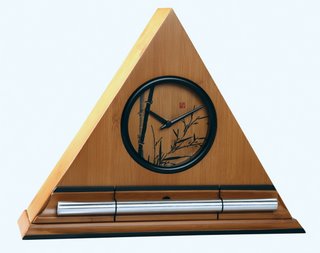 Bamboo Zen Clocks, progressive chime clock and timer adapted from Natural Home Magazine, November/December 2009 by Wanda Urbanska
Now & Zen – The Zen Alarm Clock Store
1638 Pearl Street
Boulder, CO 80302
(800) 779-6383
Posted in Bamboo Chime Clocks, Chime Alarm Clocks, Japanese Inspired Zen Clocks, Natural Awakening, Now & Zen Alarm Clocks, Sleep Habits, Well-being
 connect with nature in the morning Mornings are sacrosanct for Reiki master and energy healer E. Barrie Kavasch, a descendent of the Cherokee and Creek tribes and author of more than 15 books on Native American culture, including The Medicine Wheel Garden. “Our own internal wisdom knows this,” Kavasch explains. “We come from origins that tell us we should be up and about.” Growing up on a family farm in Tennessee, Kavasch and her siblings would wake up before dawn to milk the cows. “Our days would be filled with energy and enthusiasm. We would have done so much by 8:30 a.m.,” she says. “I can’t imagine a morning without being in close touch with nature.” Even those not living on a farm can gain from the enlivening benefits nature will bring to the tired human body.
Step outside. In many ways, getting outdoors provides the best way to get your mind and body in sync with the morning. “The first thing I do each morning is get up and go out for a walk. I fill my lungs with the morning air,” says Kavasch. Even if you don’t have time for a walk, simply stand out in the morning light to get connected with the world around you.
Open a window. If you can’t get out, bring the fresh air in. Pull open the blinds and open a window to let in the light, smells, and sounds of a new day.
See blue. Among the Pueblo and Navajo people, says Kavasch, seeing turquoise first thing in the morning is considered a blessing. This helps explain why they’ll often paint a portion of their windowsills or door frames in this brilliant color. “Turquoise is considered a sky stone, reminding us of when the sky is at its brightest and sunniest,” says Kavasch. “To see it upon first opening your eyes is a blessing for the hours that follow.” To set the stage for a better morning, try keeping a turquoise stone, bracelet, necklace, or colored item by your bedside or in your window so you see it first thing in the morning.
Water your plants. Invite nature into your home by placing houseplants throughout; then take time each morning to water and care for them. Just touching and focusing on this element of nature can gently draw you into the new day.
Enjoy a taste of nature. A bite of fresh fruit or a sip of juice can recall a vital connection to the natural world and help gently awaken your senses. Think of that taste as more than food; it represents nature’s bounty.
Waking up in the morning should be as pleasant as falling asleep at night. The Zen Alarm Clock’s gradual, gentle awakening is transformative.
Boulder, Colorado—an innovative company has taken one of life’s most unpleasant experiences (being startled awake by your alarm clock early Monday morning), and transformed it into something to actually look forward to. “The Zen Alarm Clock,” uses soothing acoustic chimes that awaken users gently and gradually, making waking up a real pleasure.
adapted from Body + Soul, March 2006
 Singing Bowl and Chime Alarm Clocks and Timers Now & Zen’s Soothing Chime Alarm Clock
1638 Pearl Street
Boulder, CO 80302
(800) 779-6383
Posted in Chime Alarm Clocks, Now & Zen Alarm Clocks, Progressive Awakening, sleep, Sleep Habits
 Orchid Sun Salutation
Perform asanas each time with a fresh mind and with a fresh approach.
1. Tadasana
Translation
Mountain Pose
 yoga mountain pose How to Do It
Stand with big toes touching, heels slightly apart. Create a straight line from ear to shoulder to hip to knee to heel. Relax your shoulders. Engage the legs; lift your kneecaps. Bring your hands together in front of your heart, keeping the collarbones and chest broad. Lift the crown of the head upward, as you take deep breaths in and out through your nose.
Modification
Stand with your feet hip-width apart, toes facing forward.
What It Does
Energizes the legs and focuses your attention, grounding you in the present moment.
 yoga upward hand pose 2. Urdhva hastasana
Translation
Upward Hand Pose
How to Do It
On an inhalation, sweep your arms out to your sides and bring the palms to touch up above your head, keeping your shoulders down. Reach through the sides of your body so your torso becomes long, gently bringing your gaze to your hands.
Modification
If you begin to feel compression in the shoulders, keep your hands 6 inches apart, palms facing each other, and look straight ahead.
What It Does
Opens the chest area and the lungs, increasing your lung capacity. “From the yogic perspective,” says Rea, “this pose activates the solar, or expansive, energy in your being.”
 yoga forward bend 3. Uttanasana
Translation
Standing Forward Bend
How to Do It
As you exhale, sweep your arms out to the sides and bend at the hips to come into a deep forward bend. Bring your fingertips to the floor alongside your feet. Let your head gently release toward the floor.
Modification
If you feel tight in your hamstrings or lower back, bend your knees so that you can bring the fingertips to the floor, or rest your hands on blocks.
What It Does
Stretches the backs of the legs and lengthens the spine. “This bowing forward is the essence of the Sun Salutation,” Rea explains. “You are bowing to the perfection of our solar system — how we’re moving around the sun and how it forms the rhythm of our life.”
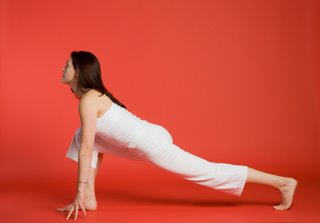 yoga lunge pose 4. Lunge Pose
How to Do It
Keeping your fingertips where they are, inhale and take a giant step back with the right foot. The left knee bends at a 90-degree angle. (Note: In your subsequent rounds of Sun Salutation, alternate the lunging leg to keep both sides of the body evenly balanced.)
What It Does
Opens the legs and pelvis; warms up and energizes the base of the body; elongates the spine.
 yoga plank pose 5. Plank Pose
How To Do It
As you exhale, bring your palms to the floor and step the left foot back to meet the right (a starting push-up position). Grip the mat with your fingers to take the weight off your wrists. Reach the top of your head forward and your heels back. Engage the abdominal muscles to come into one even line. Be careful not to let the hips either rise up higher than the lower back or sink down toward the floor.
What It Does
Activates the entire body; builds upper-body and core strength; creates heat; develops your sense of confidence and power.
 yoga four-limbed staff pose 6. Chaturanga Dandasana
Translation
Four-Limbed Staff Pose
How to Do It
At the end of an exhalation, bend your elbows straight back and lower your body down to the bottom of a push-up. Keep elbows close to your sides. Continue lengthening through the heels and the crown of the head to keep your entire body long and engaged, as you draw the navel in to activate your core muscles.
Modification
Lower the knees to the mat, coming into a modified push-up.
What It Does
This pose helps to build strength throughout the entire body. “Being strong is just as important as being flexible,” notes Rea.
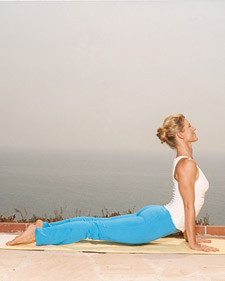 yoga upward facing dog 7. Urdhva mukha svanasana
Translation
Upward-Facing Dog
How to Do It
As you inhale, roll forward over your toes and straighten your arms. Your hips, thighs, and shins should all be off the floor. Press into the tops of your feet and palms, as you melt the heart forward past your arms. Gaze straight ahead.
Modification
Come into cobra pose instead: Rest hips and legs on the floor and straighten the arms comfortably, reaching the chest forward through the arms.
What It Does
Creates suppleness in the spine while opening the chest, lungs, and heart. So vital to our well-being, this area is frequently compromised by chronic bad posture. “Creating openness across the chest is strengthening and revitalizing,” explains Rea.
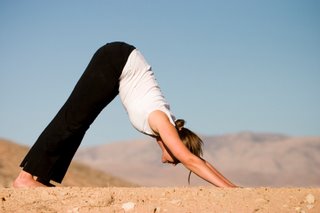 yoga downward facing dog pose 8. Aadho mukha svanasana
Translation
Downward-Facing Dog
How to Do It
As you exhale, roll back over the toes and lift the hips to come into an inverted V shape. Press your fingers into the mat and reach the thighs back, lengthening the sides of the body and the spine. Keep your shoulders down. Release the weight of your head.
Modification
If the hamstrings or lower back feel tight, bend your knees slightly. If you are unable to keep your arms straight, bring the knees to the floor and push back into Child’s Pose.
What It Does
Serves as a counterpose to Upward-Facing Dog; cools the mind; improves circulation.
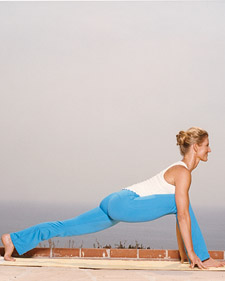 yoga lunge pose 9. Lunge Pose
How to Do It
As you inhale, step forward with the leg you initially stepped back with, coming back into Lunge pose. Keep your front knee at a 90-degree angle and your fingertips on either side of the front foot.
10. Uttanasana
How to Do It
Exhale and step your back foot forward; fold over your straightened legs, keeping your fingertips on the floor. Take a moment to notice whether your hamstrings or back muscles feel any looser than they did at the beginning of the cycle.
12. Tadasana
How to Do It
Exhale and float your arms back into prayer position. Keep the chest broad, the legs engaged, and the spine long as you enjoy the stillness of this pose. You can choose to end your session here or go on for another round.
Use our unique “Zen Clock” which functions as a Yoga Timer. It features a long-resonating acoustic chime that brings your meditation or yoga session to a gradual close, preserving the environment of stillness while also acting as an effective time signal. Our Yoga Timer & Clock can be programmed to chime at the end of the meditation or yoga session or periodically throughout the session as a kind of sonic yantra. The beauty and functionality of the Zen Clock/Timer makes it a meditation tool that can actually help you “make time” for meditation in your life. Bring yourself back to balance.
adapted from Body + Soul Magazine
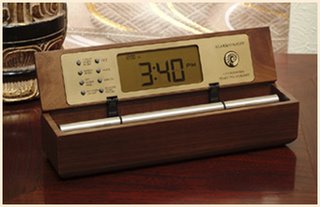 Digital Zen Yoga Timer in Walnut Finish Now & Zen’s Yoga Timer Store
1638 Pearl Street
Boulder, CO 80302
(800) 779-6383
Posted in Bamboo Chime Clocks, Chime Alarm Clocks, Japanese Inspired Zen Clocks, Yoga Timer, Yoga Timers by Now & Zen
 creating a sacred space in your garden “According to mystics, spaces aren’t sacred because of their location but because of all the prayers said on that land,” Chris Prelitz says. He offers these tips for creating sacred space outdoors.
• Find a place that’s quiet and peaceful. “Your best clue is to notice where your cats hang out,” Chris notes.
• Transform an ugly spot. Damaged land offers an opportunity for healing. Spending time in meditation and prayer at a certain place helps sanctify it.
• Remind yourself of your oneness with Creation. Place statues, art, water, candles, crystals, or stones engraved with inspiring words in your garden.
• Make places to rest. Place a chair or bench in a comfortable spot, then sit quietly. Spend time “being” rather than doing. Set your Zen Timepiece for a 20 minute meditation.
 Zen Timepiece, tibetan singing bowl timer and clock • Create ceremonies. Burn incense or sage. Write your prayers and intentions on colorful strips of paper and bury them or tie them to branches. Plant a tree as part of a ceremony. Host a wedding. Start a garden meditation circle with family and friends.
Use our unique “Zen Clock” which functions as a Yoga and Meditation Timer. It features a long-resonating acoustic chime that brings your meditation or yoga session to a gradual close, preserving the environment of stillness while also acting as an effective time signal. Our Yoga Timer & Clock can be programmed to chime at the end of the meditation or yoga session or periodically throughout the session as a kind of sonic yantra. The beauty and functionality of the Zen Clock/Timer makes it a meditation tool that can actually help you “make time” for meditation in your life. Bring yourself back to balance.
adapted from Natural Home Magazine, June/July 2005 by Marsha Scarbrough
 stillness in the garden Now & Zen’s Singing Bowl Timer Store
1638 Pearl Street
Boulder, CO 80302
(800) 779-6383
Posted in Bamboo Chime Clocks, Chime Alarm Clocks, Japanese Inspired Zen Clocks, mindfulness practice, Now & Zen Alarm Clocks, Well-being
 Toyokuni Utagawa, Flower Arrangement By skillfully managing your attention, you’re able to both experience life in a balanced way and stay oriented in a positive, productive direction. John Milton might have been thinking of the power of focus when he wrote: “The mind is its own place, and in itself / Can make a heav’n of hell, a hell of heav’n.”
Like consciousness or mind, attention is a complex neurological and behavioral business. There’s no tidy “attention center” in the brain. Instead, an ensemble of alerting, orienting, and executive networks collaborate to attune you to what’s going on in your inner or outer world in a coherent way that points you toward an appropriate response.
Along with performing the Apollonian task of organizing your world, attention enables you to have the kind of Dionysian experience beautifully described by the old-fashioned term rapt—completely absorbed, engrossed, fascinated, perhaps even “carried away”—that underlies life’s deepest pleasures, from the scholar’s study to the carpenter’s craft to the lover’s obsession. Some individuals slip into it more readily, but research shows that with some reflection, experimentation, and practice, all of us can cultivate this profoundly attentive state and experience it more often.
Considering attention’s importance, it’s surprising that until recently, science has come up with few strategies to improve it. Most new strategies have a “back to the future” quality derived from their origin in meditation, secularized and made amenable to scientific study. These cognitive regimens can strengthen attention and are both free and safe, all of which must appeal to the 78 million baby boomers and their aging children, who are equally concerned about maintaining their mental and physical health.
 Bamboo Alarm Clocks & Meditation Timers Deciding what to pay attention to for this hour, day, week, or year, much less a lifetime, is a peculiarly human predicament, and your quality of life largely depends on how you handle it. Moses got his focus from God; Picasso from his nearly supernatural creativity. We have other motivations and gifts, and most of us have to go through a more complicated process to find the right things to focus on. We must resist the temptation to drift along, reacting to whatever happens to us next, and deliberately select targets, from activities to relationships, that are worthy of our finite supplies of time and attention.
Perhaps the most important thing I’ve learned is that it shouldn’t take a crisis to show you that your life is the sum total of what you focus on or to make you question that your well-being depends on what happens to happen to you. After running that tough experiment, however, I have a plan for the rest of my life. I’ll choose my targets with care—writing a book or making a stew, visiting a friend or looking out a window—then give them my rapt attention. In short, I’ll live the focused life, because it’s the best kind there is.
Excerpted from Utne Reader, March/April 2010 from the book Rapt: Attention and the Focused Life by Winifred Gallagher
Although meditation can be done in almost any context, practitioners usually employ a quiet, tranquil space, a meditation cushion or bench, and some kind of timing device to time the meditation session. Ideally, the more these accoutrements can be integrated the better. Thus, it is conducive to a satisfying meditation practice to have a timer or clock that is tranquil and beautiful. Using a kitchen timer or beeper watch is less than ideal. And it was with these considerations in mind that we designed our digital Zen Alarm Clock and practice timer. This unique “Zen Clock” features a long-resonating acoustic chime that brings the meditation session to a gradual close, preserving the environment of stillness while also acting as an effective time signal.
 Zen Alarm Clocks with Chimes & Singing Bowls Now & Zen’s Chime Timer and Alarm Clock Store
1638 Pearl Street
Boulder, CO 80302
(800) 779-6383
Posted in Chime Alarm Clocks, Japanese Inspired Zen Clocks, Meditation Timers, Meditation Tools, Natural Awakening, Now & Zen Alarm Clocks
 yoga To find a yoga style that jibes with you, first consider whether your intentions are mainly physical, emotional, or spiritual, says Hansa, president of Yoga Alliance, an organization that registers yoga teachers nationwide. (She uses only one name.) Some people practice yoga for strength and flexibility, some crave relaxation, and some seek a connection with a higher power. (Some want all four.) There is no right or wrong reason to practice yoga, but different styles fulfill different needs. Just as if you were placing a personals ad, you need to think about what you want before you get started.
class consciousness
Yoga’s popularity has exploded of late—18 million Americans now regularly twist themselves into pretzels, more than double the number in 1997. But the sheer variety of classes to choose from can be daunting. Here’s a primer to help you decide what’s right for you.
 partner yoga ananda
founder: Swami Kriyananda
What it is: A gentle approach to postures, ananda yoga emphasizes calming the mind in preparation for meditation. Holding the postures is said to create self-awareness, and affirmations are often incorporated to enhance the poses.
Sign on if: You’re looking for a deeply spiritual experience that also builds strength and balance.
For more information: www.expandinglight.org
ashtanga
founder: K. Pattabhi Jois
What it is: The foundation of many “power yoga” or “power flow” classes, this fast-moving series of breath work and sweat-inducing poses is said to purify the mind and body. The room isn’t heated, but you’ll sweat anyway.
Sign on if: You like pushing your muscles to the max and conquering new heights of cardio endurance.
For more information: www.ayri.org
anusara
founder: John Friend
What it is: A dual focus on principles of alignment and physical expressiveness gives practitioners an in-depth understanding of the poses as well as a strong dose of spirituality. Although physically challenging, the style emphasizes accepting each student’s abilities.
Sign on if: You seek a physical and spiritual workout and are internally driven.
For more information: www.anusara.com
bikram
founder: Bikram Choudhury
What it is: Known as “yoga to the stars” because of its popularity in Hollywood, Bikram consists of a 90-minute series of 26 poses. Ideally, classrooms are heated to 105 degrees with 60 percent humidity to facilitate stretching and loosening of muscles and tendons.
Sign on if: You have a high tolerance for heat and respond well to a highly charged, athletic environment.
For more information: www.bikramyoga.com
iyengar
founder: B.K.S. Iyengar
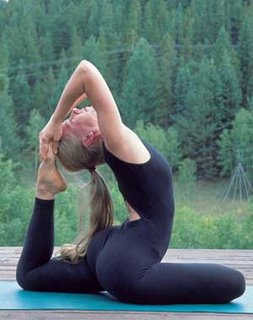 yoga What it is: Precision, alignment, and symmetry are key elements of an Iyengar class. Postures are held up to five minutes to build strength and encourage deep release. Props, such as blocks, belts, and blankets, help students hold difficult poses, but can also create a start-and-stop pace that some people don’t like.
Sign on if: You’re a detail-oriented person who likes to get things right, no matter how long it takes.
For more information: www.bksiyengar.com
kripalu
founder: Swami Kripalvananda
What it is: Slow-paced classes focus on creating an emotionally and physically safe learning environment. Offers a strong emphasis on mind-body integration.
Sign on if: Relaxation is just as important to you as building strength and increasing flexibility.
For more information: www.kripalu.org
kundalini
founder: Sikh master Yogi Bhajan
What it is: The focus is on freeing energy by awakening kundalini, the coiled energy located at the base of the spine. Despite its sexy reputation, kundalini emphasizes breathing exercises and chanting in lieu of a more physical practice.
Sign on if: The spiritual and emotional dimensions of yoga interest you more than getting a workout.
For more information: www.3HO.org
viniyoga
founder: T.K.V. Desikachar
What it is: A gentle style that incorporates asanas, chanting, breathing practices, and meditation, Viniyoga focuses on an individual’s needs and abilities.
Sign on if: You’re looking for a supportive and nurturing environment where your limitations are taken into consideration in each asana. Especially good for people with chronic health problems.
Use our unique “Zen Clock” which functions as a Yoga Timer. It features a long-resonating acoustic chime that brings your meditation or yoga session to a gradual close, preserving the environment of stillness while also acting as an effective time signal. Our Yoga Timer & Clock can be programmed to chime at the end of the meditation or yoga session or periodically throughout the session as a kind of sonic yantra. The beauty and functionality of the Zen Clock/Timer makes it a meditation tool that can actually help you “make time” for meditation in your life. Bring yourself back to balance.
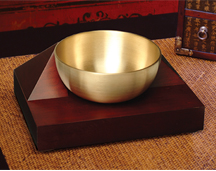 Singing Bowl Yoga Timer excerpted from Natural Solutions, June, 2003 by Catherine Guthrie
 Meditation & Yoga Timers and Clocks Now & Zen’s Yoga Timer
and Chime Alarm Clock
Store
1638 Pearl Street
Boulder, CO 80302
Posted in Chime Alarm Clocks, Japanese Inspired Zen Clocks, Meditation Timers, Meditation Tools, Now & Zen Alarm Clocks, Yoga Timer
« Previous Page — « Previous Entries
Next Entries » — Next Page »
|
|
|
|